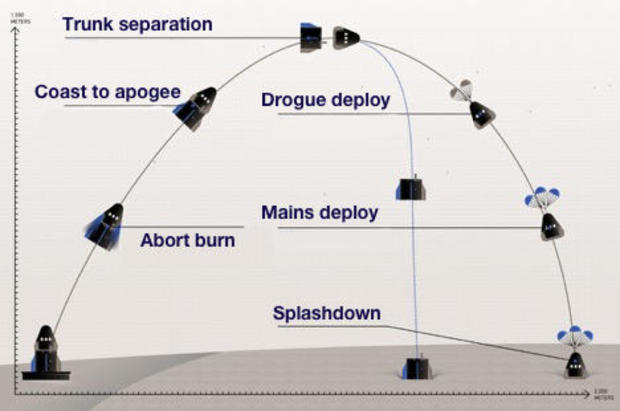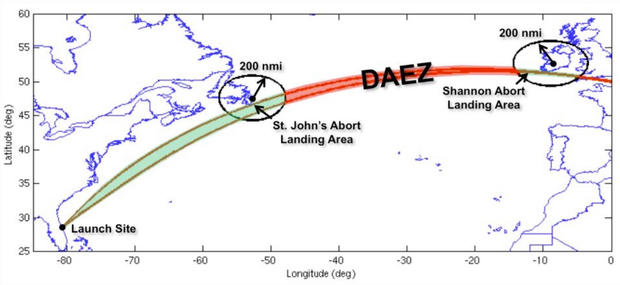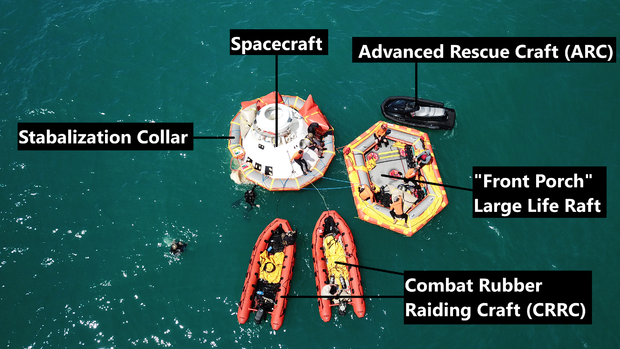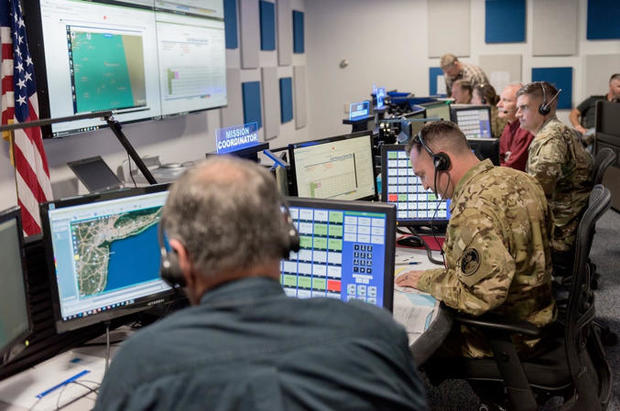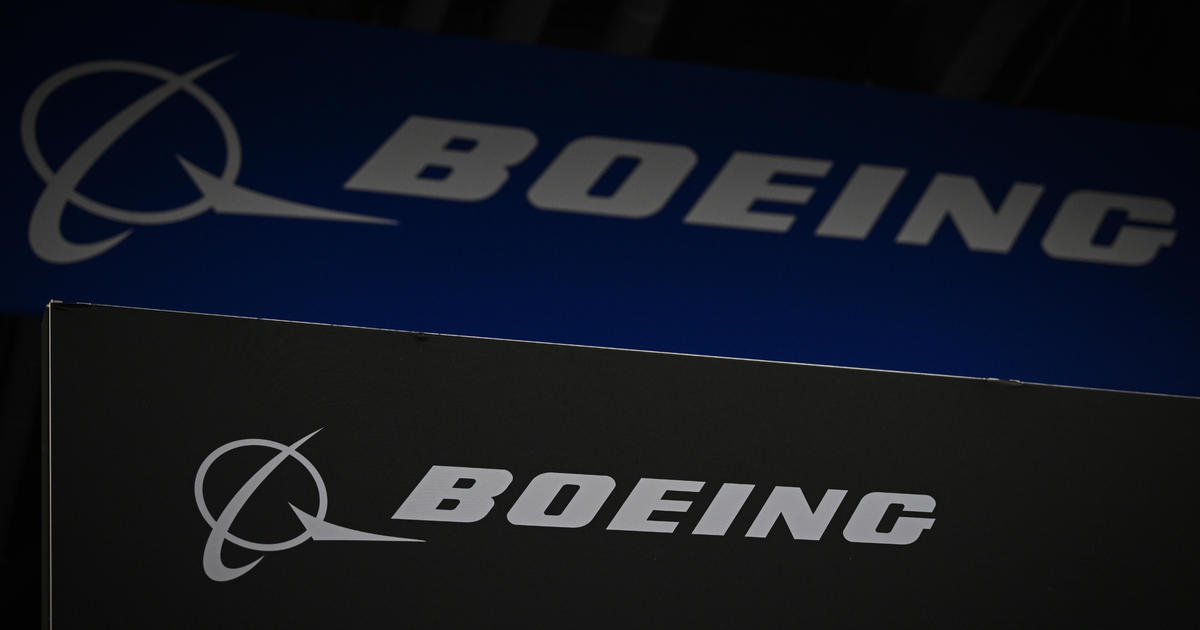SpaceX Crew Dragon abort system a major boost for crew safety
Watch live coverage on CBSN this Saturday, May 30. Launch is scheduled for 3:22 p.m. EDT.
When SpaceX's Crew Dragon takes off atop a Falcon 9 rocket, its two-man crew will enjoy a level of safety space shuttle astronauts could only dream about: an abort system designed to detect an impending booster malfunction and automatically propel the capsule to safety at any point from the pad to orbit.
But that improved safety margin comes at a cost. While a major booster malfunction during the climb to space is unlikely, NASA and SpaceX must be prepared for the possibility of an abort and an emergency splashdown anywhere along a trajectory stretching from Cape Canaveral to Newfoundland and across the North Atlantic Ocean toward Ireland.
And for a safe splashdown at the end of the mission — the first water landing for NASA astronauts since the Apollo-Soyuz Test Project in 1975 — the Crew Dragon requires relatively benign weather and sea states across a vast area.
"There (are) 50 points where we're monitoring weather, over 50 points, actually, all the way along the track ... basically to Ireland, across the northern Atlantic," said Benji Reed, director of Crew Dragon mission operations.
Along with monitoring local cloud cover, precipitation, electrical activity and winds as SpaceX does for every Falcon 9 launch, "we're looking at wave velocity and wave height, because we need to make sure that if the crew had to come down in a launch escape scenario that they would come down in a sea state that would keep them safe, and the rescue forces would be able to come and get them," he said.
The bottom line?
"I would expect there to be a very high chance of scrub due to weather," Reed said in an earlier briefing. "Given the time of year, it wouldn't surprise me at all."
Indeed, bad weather forced mission controllers to scrub the first launch attempt on Wednesday, May 27, and reschedule for Saturday.
The team will assess conditions along the trajectory on launch day, looking for enough benign areas to justify the risk of pressing ahead.
"That was one of those things that we twisted our brains around for months and months and months," said Steve Payne, a former shuttle manager who helped put together the agency's emergency rescue plans. "How much is enough? Because you can't guarantee you're going to have a good seas the entire way.
"It's like expecting every light to be green on your way to work in the morning. It's not gonna happen. You can get as many as you can, but you'll always have some patches where it's not as great as you'd like. We understand that, it's a risk we have to accept because we can't guarantee perfect weather."
The Crew Dragon can, however, avoid the stormy north Atlantic.
The spacecraft's flight computer is programmed to fly the capsule back to within 200 nautical miles of Newfoundland or forward toward the coast of Ireland in case of an abort that would otherwise drop the crew into a "downrange abort exclusion zone" between North America and Europe.
SpaceX successfully tested the Crew Dragon's abort system during a dramatic unpiloted test flight in January. An on-pad abort was carried out in 2015, proving the system can whisk a crew to safety in the event of a pre-launch catastrophe.
Boeing also is building a commercial crew ship, the CST-100 Starliner, that is expected to begin carrying astronauts next year. Like the Crew Dragon, Boeing's capsule also features a "full-envelope" abort system, one in which there are no so-called "black zones" on the way to orbit where a booster failure could leave a crew with no survivable options.
"A huge advantage (of) the capsule design is you have an abort escape capability throughout the envelope, which we did not have in shuttle," said Crew Dragon commander Douglas Hurley. "There were regimes of the flight during the ascent where if we had a particular engine failure, or a series of engine failures, you would not have the capability to abort safely."
With the Crew Dragon, the crew can abort to an ocean splashdown starting about 40 minutes before liftoff, just before fueling begins, through liftoff and all the way to orbit along a northeasterly trajectory that roughly parallels the east coast of the United States.
"The automation is typically faster than a human can react," Hurley said. "So depending on what the trigger is for that particular abort, the vehicle is highly likely to react before you do. It certainly ... does give you confidence that if you have a bad day, that the Crew Dragon is able to get you away from the launch vehicle and safely back into the water.""
Space shuttle crews had no abort options during the first two minutes of flight when the orbiter's huge solid-fuel boosters were firing and only a limited set of options to deal with the failure of a hydrogen-fueled main engine. Multiple engine failures could leave a crew with no other option but to bail out of the ship's side hatch.
With two catastrophic failures in 135 flights, the space shuttles had a demonstrated probability of loss of vehicle/loss of crew of a bit less than 1-in-70. The Crew Dragon's predicted odds are 1-in-276 for loss of vehicle and 1-in-60 for vehicle-related problems that would prevent a crew from completing its mission.
The Crew Dragon abort system is built around eight powerful liquid-fueled SuperDraco rocket engines mounted in pairs around the exterior of the capsule, each one capable of generating 16,000 pounds of thrust. A system of sensors throughout the Falcon 9 feed telemetry to the ship's flight computer, which constantly monitors the performance of critical components.
Should a major malfunction be detected, the computer is programmed to instantly fire the SuperDracos, blasting the capsule away from the Falcon 9. The abort system also can be triggered manually using a large "pull-and-twist" handle mounted between the astronauts.
During the January in-flight abort test, the abort system propelled a Crew Dragon capsule to a distance of half a mile in 7.5 seconds, accelerating the craft to 400 mph relative to the booster.
Once safely away, the capsule is designed to follow a relatively normal descent trajectory, deploying drogue chutes to stabilize the craft and then four large main parachutes, at an altitude of about 6,500 feet, to lower the capsule into the ocean. The spacecraft can safely splash down with just three main chutes and possibly two.
Rescue personnel standing by, just in case
For every Crew Dragon and Starliner launch, Air Force Detachment 3 personnel will be standing by at Patrick Air Force Base a few miles south of the Kennedy Space Center, ready to mount a rescue if a capsule aborts on the pad or in flight and lands within 200 nautical miles of the spaceport.
"If something bad happens, we want to make sure that we are prepared and ready to respond," said Lt. Col. Thompson, commander of the 45th operations group, Detachment 3.
"Another ... saying that I love is that we want to make sure that if this is their worst day that ultimately it's not their last day. We're there to make sure that even if things go bad, they'll still come back home."
Two HH-60G Pave Hawk helicopters and two HC-130 transport planes will be ready to roll on five-minute alert along with six pararescue jumpers and a combat rescue officer. For emergency splashdowns more than 200 nautical miles away, a C-17 Globemaster jet transport will be standing by at Joint Base Charleston in South Carolina with eight pararescue jumpers and a combat rescue officer.
The astronauts will be on their own until rescue teams can locate them and drop personnel and equipment into the ocean nearby.
Both SpaceX's Crew Dragon and Boeing's Starliner can provide life support at-sea for at least 24 hours. They both are equipped with radios for crews to communicate with their respective mission control centers and, through those flight controllers, with inbound rescue teams.
The capsules also will be equipped with satellite phones, electronic beacons that will broadcast a homing signal to rescue personnel and flashing lights to improve visibility.
Each spacecraft will carry an inflatable raft and survival kits that include personal radios, personal locator beacons, food, water, blankets and medical supplies. The astronauts can open the hatch and exit their capsule if needed, but the plan is for the crew to remain sealed inside until rescue personnel are on the scene.
"Once they land, typically SpaceX would power down their vehicle within a couple of hours," said Ted Mosteller, the lead for NASA's commercial crew launch, landing and rescue team. "And at that point, we would rely on the rescue radio that has that beacon on it. All of the DOD aircraft are going to be able to home in on that beacon, and that'll help them locate it.
"We'll also be given them coordinates from their mission controls. ... But once they get closer into the area where the spacecraft is, and that radio beacon on the spacecraft, they'll be able to zoom in on that and help them locate (it)."
Once rescuers find the spacecraft, the responding transport aircraft (C-17 or HC-130) will make multiple passes, air-dropping parajumpers and bundles of supplies and equipment, including rafts and watercraft, into the ocean from an altitude of approximately 3,500 feet.
If the splashdown site is near the Florida shoreline, the PJs may jump into the ocean from HH-60 helicopters hovering just above the water's surface instead of with parachutes from an aircraft flying at a higher altitude.
The initial drop would include a team of two or three rescuers who would don self-contained breathing apparatuses and approach the capsule riding Advanced Rescue Craft (ARC) — essentially modified jet skis.
Using a hazard detection kit, the PJs would conduct a sweep around the capsule to make sure no toxic propellant vapors are present.
The transport aircraft would continue to drop additional personnel and equipment, including a small Zodiac-style inflatable boat called a Combat Rubber Raiding Craft (CRRC) capable of carrying approximately six to eight people and outfitted with a 55-horsepower motor.
Next, the PJs would install an inflatable stabilization collar around the floating spacecraft. A large, specially-designed and reinforced 20-person raft would be used to create a "front porch" attached to the capsule to provide a platform for medical response.
Incapacitated astronauts can be pulled from the capsule from either the side or top hatch of the spacecraft and brought into the life raft where they would then be provided medical care if needed and prepared for movement.
The large life raft is equipped with enough food, water, and medication to support the astronauts and rescuers at sea for up to three days.
The rescue team will relay information about the crew's condition back to a DoD flight doctor. The doctor, housed in the SOC at Patrick Air Force Base, would coordinate with NASA to determine where the crew members would be transported for follow-on care.
There are a variety of ways the crew could be brought back to land, depending on where in the world their capsule splashes down.
If they are out of range of rescue helicopters, Detachment 3 would enlist the help of a U.S. Coast Guard cutter, Navy ship, or a nearby commercial vessel to pick up the rescue team and astronauts. If they are closer to shore and within range of helicopters, the crew would be airlifted back to land or directly to a hospital with a trauma center for medical attention.
After rescue, it is the responsibility of the spacecraft operator — SpaceX or Boeing — to retrieve their spacecraft.
Rescue personnel on call throughout the mission
Even after launch is complete and a crew is safely in orbit, the Charleston-based rescue team and another at Joint Base Pearl Harbor-Hickam in Hawaii will remain on standby until docking at the International Space Station. That will protect against the possibility of problems in space that might force a crew to make an emergency, off-target landing while on the way to the station or after departing.
SpaceX and Boeing have identified 150 to 200 landing sites around the world that could be targeted depending on when an emergency is declared. The crew and rescue coordinators on the ground would prioritize landing locations based upon weather and rescue force response time.
NASA and DoD rescue planners acknowledge a response to a splashdown in the Indian Ocean would likely take longer than the 24 hour requirement.
"Anytime during that free flight they could potentially make a decision that they have to abort and come back to Earth," said Thompson. "And those forces need to be ready for that. ... Hypothetically, it could come down no-kidding anywhere.
"However, they do have the ability to maintain orbit so that they can select one of their emergency landing locations. Both providers have 150 to 200 emergency landing locations selected around the globe that they can target, based on which orbit it's in at the time."
Thompson said the rescue teams were proud of their role in NASA's Commercial Crew Program.
"This is something that we as a nation are proud to bring back to the United States and we as a rescue force are proud to be here to support and be ready," he said. "We've said it before and we continue to live by the motto that 'these things we do that others may live."

